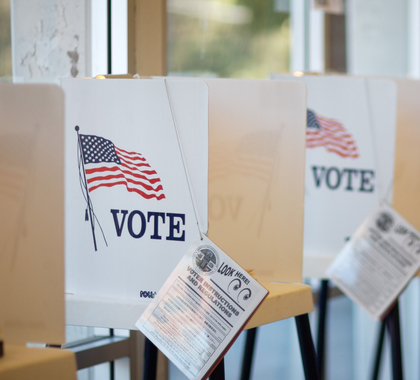Missouri voters may decide this November on whether to expand the state’s commitment to renewable energy through votes on at least one of three separate initiatives.
The initiatives would build on a 2008 initiative, Proposition C, that created Missouri’s existing renewable energy mandate requiring investor-owned utilities in the state to generate or purchase at least 15 percent of their electricity from renewable energy sources by 2021.
Under Proposition C, biomass, hydropower, solar, and wind counted as renewable sources. The initiative included a special carveout for solar power, requiring at least 2 percent of the total must come from solar installations. It also barred utilities from increasing their rates by more than 1 percent per year to pay for the renewables.
The initiative’s backers, Renew Missouri, have to gather approximately 160,000 valid signatures, equaling at least 5 percent of the votes cast in the 2016 governor’s race, by May 3 to qualify any of the initiatives for the November 2020 ballot.
Anti-Coal Goal
Even with the 2008 renewable energy mandate in place, the U.S. Energy Information Administration reports coal-fueled power plants provided 73 percent of Missouri’s net electricity generation in 2018, second to only Texas in total coal used.
Missouri’s lone nuclear power plant supplied 13 percent of the state’s electricity in 2018, and 500 wind turbines generated just 1,000 megawatts (Mw) of electricity in 2018.
To reduce the use of coal to generate electricity, one initiative would increase Missouri’s renewable energy mandate from 15 percent of retail sales in 2021 to 20 percent by 2025 and incrementally increase the required amount of renewable power to 40 percent by 2040. The second and third initiatives would each push the mandate to 20 percent by 2022, with incremental increases to 50 percent by 2040.
Each of the initiatives would eliminate the state’s solar rebate program and only allow use of renewable energy credits associated with electricity a utility actually sells to Missouri customers. All three would also increase the solar energy minimum from 2 percent to 5 percent by 2025. The latter two initiatives require utilities to purchase solar credits for 10 years from customers with solar panels.
Counting the Costs
Research consistently shows residents in states with renewable power mandates pay more on average for electric power than in states without such mandates.
When Missouri State Auditor Nicole Galloway conducted an analysis of the initiatives, her office concluded it could not calculate the effect of increasing the renewable mandate on energy prices, but experience in other states indicates it could increase them significantly.
‘Dishonest Bait-and-Switch’
The supposed rate cap has not protected Missouri ratepayers from abnormally high increases in electricity prices, says James Taylor, director of the Arthur B. Robinson Center for Climate and Environmental Policy at The Heartland Institute, which publishes Environment & Climate News.
“Missouri electricity prices have risen 21 percent since 2010, the year before the current renewable mandate took effect, which is more than double the national average,” Taylor said. “The asserted ‘cap’ in rate hikes is a dishonest bait-and-switch scheme allowing government bureaucrats to cook the books and claim phantom ‘other factors’ are responsible for the rate hikes caused by renewable power mandates.
“The ‘cap’ merely gives utilities the option of ignoring the mandate during a given year if prices rise more than 1 percent, meaning the present initiatives fail to protect Missouri consumers from future rate hikes due to increased renewable power mandates, just as it failed Missourians in the past,” Taylor said.
Taylor says utilities have figured out how to benefit, at the expense of ratepayers, from higher renewable power mandates.
“Utilities have a vested financial interest in building and operating expensive wind and solar power, since they get customers to pay the costs for building and installing expensive wind and solar equipment, while building their own profits into the equation,” Taylor said. “The ultimate loser is the consumer, who gets stuck with higher electricity bills.
“If Missouri voters would like to double the price they pay for 40 percent of their electricity, they should vote for the proposed renewable power mandate,” Taylor said.
‘Energy Sprawl’
Expanding Missouri’s renewable energy mandate would increase “energy sprawl” across Missouri’s forests and fields, say Paul Driessen, a senior policy advisor for the Committee For A Constructive Tomorrow.
“Getting just 12,000 megawatts of unreliable, weather-dependent, rated capacity from wind energy would require 4,000 three-Mw turbines, if they worked 24/7/365,” Driessen said. “In reality, Missouri would need 16,000 of these turbines, and 117,000 acres of land, to get to 12,000 Mw and charge the necessary battery backup—with still no guarantee they would generate any power on the year’s hottest or coldest days.”
Driessen says voters should consider exactly what they’ll be getting and who will really pay the health and environmental price for increased wind and solar power.
“Has anyone considered or calculated how many millions of tons of aluminum, carbon-fiberglass composites, cobalt, concrete, copper, lithium, rare-earth metals, steel, and other materials an expanded green mandate would require?” Driessen said. “How many billions of tons of soil would be removed and ore would have to be mined, using how many African, Chinese, and South American parents and children working in those mines and processing plants, getting sick and dying from the toxic and radioactive air, water, dust, and mud?
“Initiative promoters are silent concerning how they’ll dispose of the gargantuan amount of trash, some of it potentially toxic, produced when backup batteries, solar panels, and wind turbines break or wear out,” Driessen said. “What will they do with 200-foot-long turbine blades that can’t be burned or recycled?”
[email protected]) writes from Austin, Texas.

